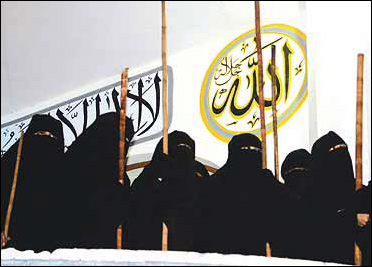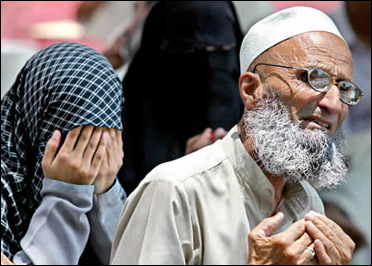READ
Pakistan Sees Musharraf Conspiracy Behind Siege of Red Mosque

|
|
 |
The
storming of the Red Mosque is not the victory that General Pervez Musharraf and his supporters in Washington proclaim. Rather, it represents the abject failure of the Pakistani president's policies. The shaky military junta seems to have few answers to the central question of containing religious extremism in the sect-ridden Pakistani society. With a growing number of citizens challenging the authoritarian system, U.S. support for Musharraf is more and more out of touch with Pakistani reality.
 | |
|
The Red Mosque problem developed right under Musharraf's nose. Under the leadership of two brothers and their brand of Islamic fundamentalism, the Red Mosque (Lal Masjid) in the capital city of Islamabad launched a campaign to establish theocracy in Pakistan and impose Islamic law (sharia). The mullahs established a private sharia court in the mosque. madrassa students forcibly occupied a children's library. They raided suspected brothels, including a Chinese massage parlor, and brought hostages to the mosque to confess and repent. Zealous students kidnapped policemen and government officials. They gave ultimatums to music and video shops to close business, and burned down one of them.
After six months of trying to appease the mullahs and ignoring their criminal vigilante action, Musharraf eventually ordered a siege against the well-armed vigilante madrassa. On July 10, Musharraf gave the go-ahead to a commando operation that left dozens dead, including Abdul Rashid Ghazi, one of the two brothers.
While there has been little sympathy for the cause of the Red Mosque, hundreds and thousands of citizens have rallied in the streets against Musharraf over the last four months. The spontaneous outpourings of people's emotions and a massive display of support for the defiant Chief Justice Iftikhar Chaudhry, suspended by Musharraf for his refusal to resign under duress, is in stark contrast to their response to the mullahs' call. The people who refuse to follow the mullah have reacted passionately in support of a beardless judge and, more to the point, against the overbearing yet incompetent Musharraf administration.
The Red Mosque tragedy highlighted one particularly incompetent aspect of the Pakistani government: the failure of the religious education reforms. More than 15,000 madrassas of five mutually exclusive sects comprise the religious education sector in Pakistan. Reforming this sector has been the centerpiece of the military regime's post-September 11 counterterrorism strategy. A plan was announced in June 2002 to regulate, modernize, and integrate madrassas into mainstream education. The failure of this roughly $100 million project could not have been more spectacular, or the government's lack of will to implement madrassa reform more evident, than in the six-month drama staged by the mullahs of the Red Mosque and its affiliate madrassas. The repercussions of Musharraf's inability or unwillingness to enforce any substantive, meaningful change in the archaic but widespread system of religious education would be grave.
The Bush administration, on the other hand, remains a generous supporter of Pakistan's education reform. The U.S. Agency for International Development is providing $83 million for education sector reform, which is part of the $1.5 billion, five-year aid program to address health, education, and governance issues in the country. A key target of this support is “religious education” which, as the madrassa tragedy in Islamabad shows, is a contradiction in terms. When the goal is not to promote secular education but to reform and upgrade religious schools, the results could hardly be different from what happened at the Red Mosque.
|
|
|
The
scene of the action was a state-run mosque and its adjacent madrassa for girls that had been built on state land. It is inconceivable that a madrassa smack in the middle of the country's capital, whose administrators had been on government payroll, should remain outside of the much-hyped and well-financed reform programs. What makes the episode all the more surreal is that the Red Mosque's call for sharia had elicited no legal action by the government. Also, other than a few pockets in the already Talibanized Pashtun areas, the vigilantism of the madrassa force garnered virtually no support in any quarter of Pakistani society. No mainstream religious party or madrassa union had backed the two brothers' cause.
 | |
|
Leaders of the Deobandi sect, also the Red Mosque's creed, had almost unanimously condemned its proclamation of sharia by force. Fazlur Rahman and Samiul Haq, the main patrons of the Taliban in Pakistan, were quick to repudiate the renegade mullahs. madrassas of other Sunni and Shia sects distanced themselves from the Red Mosque, and its radical ideology did not spread to any of the hundreds of other madrassas in the capital city itself. The Red Mosque mullah, Abdul Rashid Ghazi, was not a rabble-rousing orator. Nor did he lead a mainstream religious organization. No significant section of citizens or clergy of any sect in the capital joined him.
Given the limited influence of the Red Mosque, the timing of the recent actions was suspicious. It coincided with and eventually overshadowed an impassioned movement of lawyers against Musharraf's decision to fire the chief justice. Now, cynicism is rife in Pakistan. The heavy loss of human life adds to it an air of gloom. The delayed decision to tackle the renegade mullahs, after months of velvet-glove treatment, undercuts the general's anti-extremism rhetoric. What could have been nipped in the bud by resolute civil administrative action was inexplicably allowed to linger on long enough to turn into a full-blown armed conflict.
The Red Mosque lies in rubble, and so does the government's madrassa reform. None of the major international commitments the regime had made to meet the demands of the UN Security Council's anti-extremism resolutions has been fulfilled. A review of its performance reveals the hollowness of the regime's claim to be a bulwark against extremism. In fact, the violence instigated by the Red Mosque was a direct result of the gap between this regime's words and action.
| |
Failed Reform
 |
|
 |
The
list of failed reform plans is long. Disarming the radical madrassas was on top of the government's agenda. As the Red Mosque standoff showed, however, the disarmament did not go very far. Even in Islamabad's madrassas, arms and explosives flow freely. Arms have become a part of the madrassa culture across the sectarian divide. In fact, government officials have encouraged the mullahs embroiled in Sunni-Shia sectarian feuds to keep weapons since the state doesn't have the funds to provide them all with police protection. Most of the radical madrassas have direct or indirect links with banned militant organisations. If the government eventually decided to disarm the madrassas, there would be stiff resistance. In any case, the Musharraf regime lacks the resolve as well as the political credibility to achieve this critical policy goal.
 | |
Muzazamil Shah, whose 17-year-old son was in Lal Masjid, prays with his wife outsideLal Masjid on July 7 |
Another component of the proposed reform was a monitoring and regulatory regime. The registration and financial audit of madrassas under a proposed new law was the starting point. For about five years the government has been negotiating the fine print of the registration law with madrassa administrators. The law supposed to be in force now is toothless and non-intrusive. Even under this meek mechanism, the task of registration is far from complete. Pakistan has also yet to fully and formally accede to the International Convention for the Suppression of the Financing of Terrorism. In the wake of the Red Mosque fiasco the Musharraf government should publicize the names of the donors of this rebellious madrassa and then extend the net to all donors to make madrassa financing transparent.
The core of the reform project was a new madrassa curriculum. The government had pledged to modernize the curriculum by adding new courses in English, mathematics, Pakistan studies, social studies, and general science at various levels. The professed aim was to bring madrassas closer to formal education. The government had also promised to cover the costs of books and additional teachers for non-religious subjects, teacher training, library materials, computers, and other supplies. Any madrassa properly registered with the government could apply for assistance. In June last year, however, the education minister announced that no further government money would be given to madrassas for curricular reforms and related supplies until the madrassa boards signed an agreement with the government to abide by the stipulated terms of registration and regulation. madrassa union leaders refused to do so and the program failed before it could take off. In any case, secular educational courses would only be of value if there were also fundamental changes in the religious curriculum of all sects to end the promotion of sectarianism and religious intolerance, which is the original rationale of madrassas.
Finally, madrassas have proliferated in part because many have illegally occupied public land. The Council of Islamic Ideology, an official advisory body on religious matters, and advocacy groups such as the International Crisis Group have repeatedly urged the government to remove those mosques and madrassas built on occupied land. It is only after much blood has been shed that the Red Mosque's illegal madrassa for girls may be razed. Given Musharraf's past performance, it is highly unlikely that this policy will be extended to thousands of other such unauthorized mosques and madrassas throughout the country.
The military government's performance on madrassa reforms makes it clear that it lacks the vision, the will and the political legitimacy to put in place a process of long-term change. More concessions to the madrassas without making them comply with the demands of reform will further encourage the forces of religious extremism. The desperate measures taken to flush out the Red Mosque militants would amount to little if the thousands of other madrassas continue to preach arcane versions of rival Islams. Even if not all of them are militant, the potential for violence will continue to grow unless the madrassas are subjected to a rigorous regulatory regime and made to adjust to the demands of modern education -- a task that has so far proved beyond the grasp of the generals.
Neither the military nor the mullahs have ever won a popular mandate in Pakistan. The reaction of the general public in Islamabad and elsewhere in the country to the campaign for Talibanization is also instructive in this regard. By shunning the mullahs of Islamabad and not extending any support whatsoever to their sharia plans, Pakistani people have once again dispelled the notion it is a society prone to religious radicalism, as the Bush administration and most of the rest of the West tend to believe.
Indeed, this fear of an extremist Muslim country motivates the U.S. policy of supporting Musharraf at all costs. The Bush administration has no objection to the general's Machiavellian plan to prolong his military rule through manipulation of the political system, intimidation of the judiciary, and suppression of democratic forces. The Pakistani president's failure to use U.S. aid to address extremism at the roots only reinforces this Machiavellianism for it encourages the use of the military as a last resort. Washington might like to see a few more Red Mosque-like incidents as proof of Musharraf's determination to battle extremists. But the patience of the Pakistani people, tired of religious fundamentalism from the mullahs and military fundamentalism from their president, is wearing thin.
Article courtesy Foreign Policy in Focus
Najum Mushtaq is a journalist and contributor to Foreign Policy in Focus
Comments? Send a letter to the editor.Albion Monitor July
14, 2007 (http://www.albionmonitor.com)All Rights Reserved. Contact rights@monitor.net for permission to use in any format. |
|






